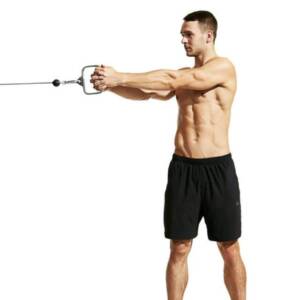
Core activation is important for many movements in everyday life. Your core is pivotal in swinging a golf club, paddling a paddleboard, and even lifting a heavy box.
Many exercises work the core, but few work it as intensely as the wood chop. This exercise keeps your trunk activated in a rotational movement pattern, as well as multiple abdominal and back muscles for stability. In addition, your legs and arms provide stability and mobility.
The wood chop exercise has been used in a variety of ways. Most notably, in rehabilitation it’s used to treat and manage lower back pain.
It can be performed in a variety of positions, as well as with different resistance tools, to allow variety and challenge. Furthermore, the different positions and tools allow you to target various muscle groups.
How too:
The most popular version of the wood chop involves a dumbbell.
Start with your feet shoulder-width apart and parallel to each other. Hold a dumbbell with both hands, either at the ends or clasping your hands at the handle.
Hold the dumbbell at the side of your right hip. Doing so means your body will be rotated to the right. Pivot your feet to the right also to avoid straining your back.
The execution
There are two phases to this movement — the lift and the chopping movement.
During the first phase, with the dumbbell at the outside of one hip, lift and rotate the dumbbell up above the outside of the opposite side of your head. For instance, if you start at your right hip, you will lift it up to the left side of your head.
As you lift, pivot your right foot to aid the rotation and elevation of the weight. In this standing version, there will be minimal movement of the trunk. Most of the motion comes from your arms and pivoting on your foot.
The second phase involves the chopping motion of the movement. The weight will go from above the left side of your head back to your right hip. Pivot on your left foot as you do this. Also, remember to keep your trunk and head tall as you perform this part of the movement.
Keep the movement controlled, and pause between each rep to decrease the momentum used.
